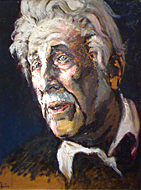At age 15 I moved to Helsinki to study at a gymnasium specializing in fine art. My family remained in California, and relatives lived outside the city except for grandfather Georg, a recently widowed painter.
He lived in a cobwebbed apartment on the top floor of a Jugend fortress built during the Russian era. The building looked confidently over the officers’ casino on the frozen bay as if it was expecting the imperial schooner to dock shortly at its feet, and Alexander the Blessed to hop ashore and claim back his old Grand Dutchy. He had an excellent library, which could only be accessed using a ladder so as to not disturb the dust (which, if it got in the air, could have been deadly to the asthmatic inhabitant).
Grandpa Georg tutored me in languages and the history and philosophy of art. I studied Swedish conjugations late into the night with the help of strong black Caravan tea in his studio, and accompanied him on morning excursions where he taught me his methods of ”people-snapping” (quick sketches on café napkins with a felt tip pen) and painting aquarelle landscapes in any weather. Although he and I inhabited different centuries (the sight of him in public without a decent black tie would have been scandalous), we were both rather lonely, and I began to genuinely value the company of the gruff old aristocrat.
More than anything he was intellectually preoccupied with the notion of beauty. He held beauty to be a value on its own, saw it originating in nature, and considered its reverence a precondition to ethical human discourse and politics. The task of the artist was to be the intermediary who raised in his audience an awareness of beauty where none was apparent – within unremarkable landscapes and unappreciated members of society – and thus a sensibility for the subjects’ worthiness. Although he disliked Heidegger, he was closely aligned with phenomenology in emphasizing intentionality (consciousness being always about some external object) and, through the craft of painting, the portrayal of the world as it presented itself to the eye, as free of presuppositions and intellectualizing as possible.
Speaking about his teacher, the early 20th-century Russian painter Valery Semenoff-Tianchansky, he says:
”When I think about Valery Semenoff-Tianchansky, and what he, an old man, meant when he exclaimed: ”Look! Just look at that field!” It may have been wheat growing, or perhaps rye – it was the color of bronze, and quite spectacular. He said: ”There is nothing more beautiful in existence.” His friend Picasso — he said Picasso could not have painted that. And indeed Picasso couldn’t. Because no man is capable of painting it. We can only adore it, and try to teach others to revere it too. ”
The full 8 1/2-minute interview is below.
Painter Georg Engeström a.k.a. GEM (1921-2008) reflects on his life’s work and the role of the artist as an intermediary between man and nature. This interview was recorded at his summer home in Finland shortly before the opening of his 85th anniversary exhibition. Although GEM applied a range of methods (he studied the fresco in Italy and spent five decades as a political cartoonist), and painted thousands of portraits during his 70-year career, he is still mainly known as a landscape painter. His work was influenced by Goya, Turner, and – more than any other – the Russian master Ilya Repin (he was born in Repin’s home village). He passed away in 2008.
